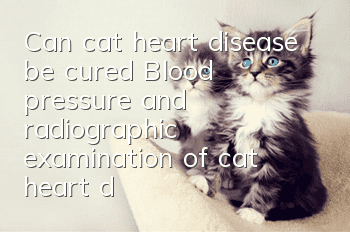Can cat heart disease be cured? Blood pressure and radiographic examination of cat heart disease!

Cats
Can cat heart disease be cured? Blood pressure and radiographic examination of cat heart disease! The basic examination of a cat’s heart is to listen to the heart sounds, check the heart rate, or detect the heart disease based on the breathing frequency Abnormalities, these can detect cardiac abnormalities in time. Of course, discovering abnormalities is the first step. To further diagnose the condition, blood pressure measurement, radiographic examination, cardiac ultrasound examination, etc. must be used.
1. Blood pressure examination
The methods of blood pressure measurement are divided into direct invasive and indirect non-invasive. Direct invasive blood pressure measurement is the best method. However, it is technically difficult to implement in unsedated cats, and common side effects are pain or hematoma. The advantage of the non-invasive method is that it requires only slight security restrictions and is easy and convenient to operate. Non-invasive methods include auscultation, Doppler, pulse amplitude, and photoplethysmography.
All non-invasive blood pressure checking methods require the use of an inflatable tourniquet tied to the limb for measurement. The pressure of the tourniquet is measured through a sphygmomanometer or pressure sensor. The pressure ball is pressurized, and then the release valve is used to release the pressure, and the scale on the pressure mark is read. However, the method of monitoring blood flow is different.
1. Auscultation: Place the stethoscope on the artery proximal to the tourniquet. When the inflation pressure gradually drops to the systolic pressure, you will hear the sound of blood flow. This is the systolic pressure, but the animal In terms of arterial blood flow sound, it is usually small in frequency or amplitude, and the auscultation method is not suitable for cats.
2. Doppler type: Place the detector on the artery in the wrist, and use an amplifier to amplify the sound so that the operator can easily hear the sound of blood flow.
3. Pulse wave amplitude type: Because if the tourniquet detects a pulse, it will pressurize until the pulse disappears, and then release the pressure to measure systolic blood pressure, diastolic blood pressure, mean arterial pressure and pulse rate. .
4. Photoplethysmography: Use the infrared attenuation change method to calculate arterial volume. This method was originally designed for use on human fingers, so it can be used on cats less than 10 kg.
Photoplethysmography machines are more expensive, and the objects of use are limited. The auscultation method is difficult and difficult to operate. Therefore, the Doppler method and the pulse amplitude method are most commonly used clinically, but the pulse wave method is the most common. The amplitude type requires a long measurement time for cats and the loud inflating sound of the machine makes it difficult for cats to use. However, the disadvantage of the Doppler type is that the calculation and measurement of diastolic blood pressure or average pressure are inaccurate. In terms of non-invasive measurement methods, it is still recommended that the "Doppler blood pressure monitor" is the best choice for blood pressure measurement.
2. X-ray diagnosis
When a cat lies on its side under The chambers of the left heart tend to be more cephalad, while the chambers of the left heart tend to be more caudally inclined. The shape of the heart is oval, with the angle extending from the branches of the trachea toA line drawn at the apex of the heart will form an angle of approximately 45 degrees with the sternum. In cats, the angle will decrease as they age, possibly due to the decrease in elasticity of the aortic connective tissue.
The correct position range for X-ray examination of cat heart disease should be from the first rib to the first lumbar vertebra. A complete chest image has been obtained. The center of the lateral view should be aligned with the 4th to 5th intercostal space, and the front view should be aligned with the 4th to 5th intercostal space. The position of the heart is different between the scapula edge and the left and right radiographs. On the left radiograph, the apex of the heart is usually too high above the sternum, and the contact area with the sternum is widened, which is often mistaken for an enlarged right heart. Therefore, we often choose to take the right side lying down film; in the front view, the position of the heart may fluctuate slightly due to gravity, and the pulmonary blood vessels at the hilum are more obvious during pulmonary ventilation. The shape of the heart is round in the X-ray, and longer in the ventral and dorsal anteroposterior X-rays. Therefore, doctors usually choose one side X-ray combined with the front X-ray to help diagnose heart disease. Sometimes it is necessary to take both side X-rays. film to clearly assess the condition of the lung fields.
- Is there a difference between cat paws and dog paw prints? How to tell the difference?
- Does your cat refuse to be groomed? This is very important to her!
- Why is the cat twitching?
- The cat has a small patch of bald skin and smooth skin
- Will soft stools improve on their own if they change cat food?
- Two month old kitten keeps crying
- What should you pay attention to when adopting a cat?
- Norwegian Forest Cat Postpartum Care Precautions
- Why are cats so soft and flexible? Illustration of cats’ unique bone structure
- Can pregnant cats eat yogurt?



